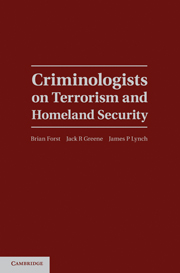Book contents
- Frontmatter
- Contents
- About the Authors
- Preface
- 1 Introduction and Overview
- PART I NATURE OF THE PROBLEM
- PART II STRATEGIES FOR INTERVENTION
- 7 Is Crime Prevention Relevant to Counterterrorism?
- 8 Implications of Opportunity Theory for Combating Terrorism
- 9 Soldiers and Spies, Police and Detectives
- 10 Community Policing and Terrorism
- 11 Go Analyze!
- 12 Managing the Fear of Terrorism
- 13 Should Profiling Be Used to Prevent Terrorism?
- 14 Federal-Local Coordination in Homeland Security
- 15 Liberty and Security in an Era of Terrorism
- 16 Regulating Terrorism
- PART III THINKING ABOUT TOMORROW
- Index
- References
14 - Federal-Local Coordination in Homeland Security
Published online by Cambridge University Press: 04 February 2011
- Frontmatter
- Contents
- About the Authors
- Preface
- 1 Introduction and Overview
- PART I NATURE OF THE PROBLEM
- PART II STRATEGIES FOR INTERVENTION
- 7 Is Crime Prevention Relevant to Counterterrorism?
- 8 Implications of Opportunity Theory for Combating Terrorism
- 9 Soldiers and Spies, Police and Detectives
- 10 Community Policing and Terrorism
- 11 Go Analyze!
- 12 Managing the Fear of Terrorism
- 13 Should Profiling Be Used to Prevent Terrorism?
- 14 Federal-Local Coordination in Homeland Security
- 15 Liberty and Security in an Era of Terrorism
- 16 Regulating Terrorism
- PART III THINKING ABOUT TOMORROW
- Index
- References
Summary
Any legislative change which would render … local and state law enforcement subservient to federal jurisdiction, would, in my opinion, be disastrous.
– J. Edgar Hoover 1954[A]gencies at different levels of government will, as a generality, have different organizational cultures that are not ideally suited to the development of effective countermeasures against the crime and related problems each agency targets.
– William Geller and Norval Morris 1992INTRODUCTION
Lack of coordination and cooperation between law enforcement officials at all levels of government has received prominent attention since the terrorist attacks on United States soil on September 11, 2001. The contentious relationship between the FBI and local police is depicted regularly in television and film; it is one of the stock Hollywood clichés in police and crime dramas. Local police have complained for many years about being patronized, alienated, upstaged, or simply ignored by FBI agents (Geller and Morris 1992). Whereas the relationship between the FBI and state and local police is the most obvious and visible issue in federal-local coordination for homeland security, the more general concern is how the federal government's entire alphabet soup of agencies can work cooperatively with local governments to secure the homeland. Concerns about terrorism have brought these issues to the forefront, with news reports, professional associations, think tanks, and government commissions all coming to similar conclusions: The linkages between federal and local agencies need significant improvement if we are to prevent terrorist incidents on American soil and enhance homeland security.
- Type
- Chapter
- Information
- Criminologists on Terrorism and Homeland Security , pp. 322 - 356Publisher: Cambridge University PressPrint publication year: 2011
References
- 3
- Cited by



